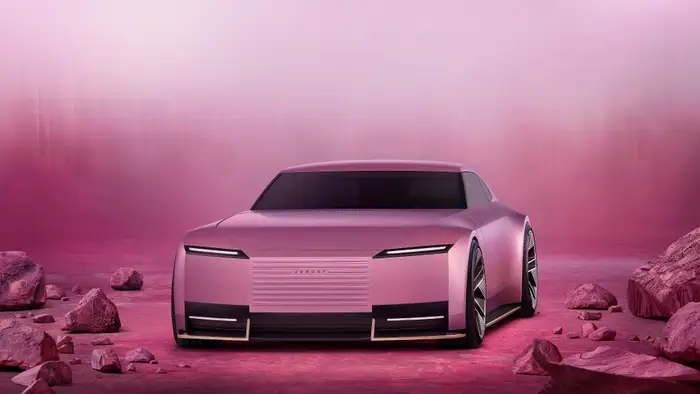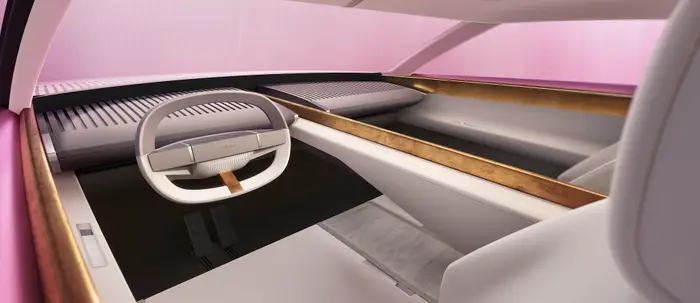Jaguar’s rebranding rollout was either a ‘brilliant’ way to get attention — or a ‘dangerous strategy.’ Ad vets weigh in.

Jaguar’s concept car came after a controversial reveal of the brand’s new image.
Jaguar has generated a lot of buzz since unveiling its rebranding campaign, culminating this week with the release of a conceptual design for its next generation of electric vehicles.
When the luxury British carmaker debuted its redesigned logo, brand philosophy, and promotional video last month, it stirred up controversy on social media. Some conservative personalities argued that the new aesthetic abandoned Jaguar’s heritage and pushed into “woke” politics, while others questioned why the promo video didn’t feature any cars.
That first phase of Jaguar’s rebrand had some advertising veterans divided on whether the strategy was a smart move for the iconic brand.
And that division carried through to Jag’s latest update on Monday, which finally paired images of cars with its “exuberant modernism” vision. Now that concept cars are connected to the initial rebranding video, some marketing professionals are praising Jaguar’s “brilliant” strategy — while others remain less convinced.

Jaguar’s video ad, released in November, featured models in colorful, modern clothing but didn’t show any cars.
“Jaguar’s paced unveiling is a brilliant strategy to keep people talking and interested in a highly competitive auto marketplace,” Jim Heininger, the founder and principal of the Chicago firm The Rebranding Experts, told B-17 after seeing the conceptual car rollout.
“This is a master class in what rebranding can accomplish for a company — a new forward-facing product and brand, clearly designed for its new customer persona, that everyone is talking about,” he said.
Heininger — whose 30-year career includes work for P&G, McDonald’s, and Anheuser-Busch — argued that Jaguar set high expectations when it debuted its controversial rebrand last month.
He said the concept car unveiling delivered on those expectations. The car effectively signals the company’s “boldly modernistic” vision and “departure from the past,” he said. The colors, design shapes, and new logo “feel right when you see it on the concept car.”

A front view of Jaguar’s concept car.
Greg Andersen, the CEO of the Omaha, Nebraska, creative agency Bailey Lauerman, also lauded Jag’s marketing strategy.
“What exceeds expectations is the breadth and depth of the Jaguar brand vision,” said Anderson, who’s worked for brands such as Google, Levi’s, Burberry, and Axe before joining Bailey Lauerman.
“They have revealed much more than a concept car,” he said. “It seems it is the beginning of the story of the Jaguar brand vision, which they can easily chapter out and stretch to the production model reveal.”
But looking to the future, Andersen said the company’s strategy has to remain well-executed when it comes time to reveal its new EV, which the company has said it expects to happen in late 2025 before hitting showrooms in 2026.
“I think the biggest risk for them now is making sure the production model lives up to the promise and doesn’t suffer death by a thousand cuts,” Andersen told B-17. “Rolling out an unapologetic, future-facing brand along with a marginally better car might not go so well.”
The proof of success will be in the production model
Still, not all of the ad veterans who spoke to B-17 had so much praise for Jaguar and its rebranding rollout.
Christos Joannides, the founder and creative director of the luxury branding agency Flat 6 Concepts in Los Angeles, told B-17 that Jaguar’s initial rebranding announcement did too much all at once, “overwhelming and confusing” the carmaker’s long-standing audience.
And, in releasing its concept car this week, Jaguar didn’t do enough to ground its new ethos in reality, Joannides said.
Joannides, who’s worked with Jaguar competitors like Maserati and Lotus, argued that the concept car’s features, like the rear with no window and the brass-toned divider running through the middle of the cabin, are impractical and bizarre.

Three brass lines run through the length of the concept car, with one right down the middle.
“By showcasing a production model with more realistic features, Jaguar could have conveyed its vision more effectively and provided tangible evidence of its direction,” Joannides said. “As it stands, the concept car feels superficial and gimmicky, like a desperate attempt to be different without any real substance or coherent strategy.”
Joannides said that while Jaguar’s initial teaser video was “certainly audacious,” the final product would be what matters.
Richard Brandon Taylor, the founder and CEO of the UK-based brand consultancy firm Brandon, told B-17 that while Jaguar’s rebrand was a smart play in some ways because it got everyone talking, there’s still a significant period of time before the first production model comes out to try to maintain that buzz.
“Why they’ve left a year between concept and car is beyond me — that is a dangerous strategy to play,” said Taylor, who’s worked with brands like Coca-Cola, Kraft Heinz, and Kimberly-Clark.
Sunny Bonnell, the cofounder and CEO of the strategic branding firm Motto, said that to hold the audience’s attention until the new cars hit the market, Jaguar needs to dive deeper into the “why” behind the rebrand.
“What does ‘Copy Nothing’ mean in practice?” said Bonnell, who’s worked with brands like Google and Virgin. “How will it shape the driving experience, not just the look?” To do that, Jaguar needs a storytelling narrative, she said.
Jaguar’s next steps in its rebranding rollout
It’s unclear which specific design elements of the new concept will be implemented in Jaguar’s forthcoming electric-vehicle models. Jaguar said its concept car was “an indicator of design philosophy and intent for the coming new vehicles,” which are expected to be available for purchase sometime in 2026.
The new EV model will use dedicated Jaguar Electric Architecture, have a projected driving range of up to 430 miles on a single charge, and be able to add up to 200 miles of range after 15 minutes of rapid charging, the company said.
And the new EVs are expected to be much more upscale than previous Jags. Though Jaguar has not confirmed a price range, Wired reported, without citing a source, that the new Jag could cost at least $127,000 — a significant increase from current average price of around $70,000.
“We have forged a fearlessly creative new character for Jaguar that is true to the DNA of the brand but future-facing, relevant, and one that really stands out,” Rawdon Glover, Jaguar’s managing director, said of Monday’s concept debut.






